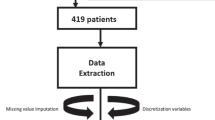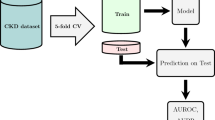Abstract
This work aims to help in the correct and early diagnosis of the acute kidney injury, through the application of data mining techniques. The main goal is to be implemented in Intensive Care Units (ICUs) as an alarm system, to assist health professionals in the diagnosis of this disease. These techniques will predict the future state of the patients, based on his current medical state and the type of ICU.
Through the comparison of three different approaches (Markov Chain Model, Markov Chain Model ICU Specialists and Random Forest), we came to the conclusion that the best method is the Markov Chain Model ICU Specialists.
Access this chapter
Tax calculation will be finalised at checkout
Purchases are for personal use only
Similar content being viewed by others
References
Ostermann, M., Joannidis, M.: Acute kidney injury 2016: diagnosis and diagnostic workup. Crit. Care 20, 299 (2016)
Hoste, E.A.J., Clermont, G., Kersten, A., Venkataraman, R., Angus, D.C., De Bacquer, D., Kellum, J.A.: RIFLE criteria for acute kidney injury are associated with hospital mortality in critically ill patients: cohort analysis. Crit. Care 10, R73 (2006)
Cruz, H., Grasnick, B., Dinger, H., Bier, F., Meinel, C.: Early detection of acute kidney injury with Bayesian networks. (2013)
Kate, R.J., Perez, R.M., Mazumdar, D., Pasupathy, K.S., Nilakantan, V.: Prediction and detection models for acute kidney injury in hospitalized older adults. BMC Med. Inform. Decis. Making 16, 39 (2016)
Bagshaw, S.M., George, C., Bellomo, R.: A comparison of the RIFLE and AKIN criteria for acute kidney injury in critically ill patients. Nephrol. Dial. Transplant. 23, 1569–1574 (2008)
Breiman, L.: Random forests. Mach. Learn. 45, 5–32 (2001)
Spedicato, G.A., Signorelli, M.: The R package “markovchain": Easily Handling Discrete Markov Chains in R. CRAN (2014)
Ye, N.: A markov chain model of temporal behavior for anomaly detection. Proc. 2000 IEEE Syst. Man, Cybern. Inf. Assur. Secur. Work. 171–174 (2000)
Ferri, C., Hernández-Orallo, J., Salido, M.A.: Volume under the ROC surface for multi-class problems. In: Lavrač, N., Gamberger, D., Blockeel, H., Todorovski, L. (eds.) ECML 2003. LNCS (LNAI), vol. 2837, pp. 108–120. Springer, Heidelberg (2003). doi:10.1007/978-3-540-39857-8_12
Sokolova, M., Japkowicz, N., Szpakowicz, S.: LNAI 4304 - Beyond Accuracy, F-Score and ROC: A Family of Discriminant Measures for Performance Evaluation (2006)
Wainberg, M., Alipanahi, B., Frey, B.J.: Are random forests truly the best classifiers? J. Mach. Learn. Res. 17, 1–5 (2016)
Acknowledgments
This work is supported by the NanoSTIMA Project: Macro-to-Nano Human Sensing: Towards Integrated Multimodal Health Monitoring and Analytics/NORTE-01-0145-FEDER-000016 which is financed by the North Portugal Regional Operational Programme (NORTE 2020), under the PORTUGAL 2020 Partnership Agreement, and through the European Regional Development Fund (ERDF).
Author information
Authors and Affiliations
Corresponding author
Editor information
Editors and Affiliations
Rights and permissions
Copyright information
© 2017 Springer International Publishing AG
About this paper
Cite this paper
Nogueira, A.R., Ferreira, C.A., Gama, J. (2017). Acute Kidney Injury Detection: An Alarm System to Improve Early Treatment. In: Kryszkiewicz, M., Appice, A., Ślęzak, D., Rybinski, H., Skowron, A., Raś, Z. (eds) Foundations of Intelligent Systems. ISMIS 2017. Lecture Notes in Computer Science(), vol 10352. Springer, Cham. https://doi.org/10.1007/978-3-319-60438-1_6
Download citation
DOI: https://doi.org/10.1007/978-3-319-60438-1_6
Published:
Publisher Name: Springer, Cham
Print ISBN: 978-3-319-60437-4
Online ISBN: 978-3-319-60438-1
eBook Packages: Computer ScienceComputer Science (R0)




